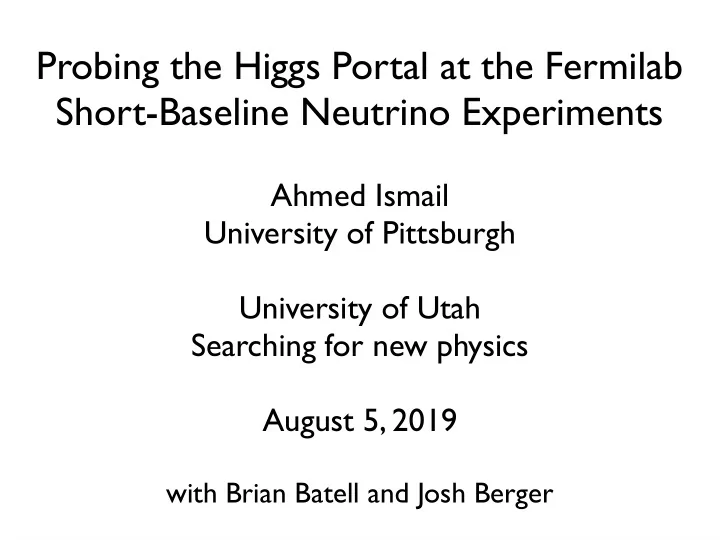

Probing the Higgs Portal at the Fermilab Short-Baseline Neutrino Experiments Ahmed Ismail University of Pittsburgh University of Utah Searching for new physics August 5, 2019 with Brian Batell and Josh Berger
Summary Neutrino experiments as proton beam dumps to probe light hidden sectors Fermilab Short Baseline SBN to probe Higgs Neutrino (SBN) facility portal 2
Light hidden sector portals - light dark matter - muon g – 2 - neutrino masses - ... dark Higgs dark photon sterile neutrino 3
Current limits on the Higgs portal Scalar couples to SM through mixing with Higgs Physics Beyond Colliders BSM report Rare decays of B, K mesons 4
Dark sectors at the Intensity Frontier meson facilities long-lived particle searches beam dumps 5
Neutrino beams are proton dumps 6
Short Baseline Neutrino program Detector Mass (t) Distance (m) SBND 112 110 MicroBooNE 60 470 ICARUS 760 600 7
Neutrino experiments as probes of hidden sectors e - p S e + Facility Proton energy Protons on target Booster 8 GeV 7 x 10 20 NuMI 120 GeV 8 x 10 21 CHARM 400 GeV 2 x 10 18 SPS, CERN 8
Producing scalars at beam dumps Booster NuMI Booster: 8 GeV NuMI: 120 GeV Stopped kaons not shown 9
Advances in detector technology Water Cerenkov Liquid argon Tank lined with PMTs ns timing resolution e.g. Super-K Fermilab SBN detectors 10
Neutrino events are now background Photons travel ~10 cm before pair conversion, so most gg events look different from ee ArgoNeuT, 1610.04102 11
Neutrino events are now background GENIE returns objects: electrons, muons, pions, photons, protons Need kinetic energy of Assume conservatively tens of MeV to leave no discrimination enough hits in LAr between muons and + smearing pions possible 12
Reducing the background Require 2 e/ g or m / p , nothing else (neutrons, nuclear remnants still allowed) Cut on pair invariant Booster mass Fraction of events 100 MeV S Reconstructed scalar is → boosted cut on angle wrt beam line, energy Background Angle between S and beam line 13
Off-axis production Absorber stops beam ICARUS (and m BooNE) → kaons decaying at rest ~7 degrees off NuMI (KDAR) signal beam line Slower scalars traveling shorter distance to ICARUS NuMI target NuMI absorber ← 700 m → p p ← 100 m S S kaon decaying in fight → kaon decaying at rest ICARUS 14
Kaons decaying at rest NuMI Monoenergetic scalars Fraction of events come from direction of 100 MeV S absorber Background is still from kaons produced in target Background Angle between S and beam line NuMI target NuMI absorber ← 700 m → p p ← 100 m S S kaon decaying in fight → kaon decaying at rest ICARUS 15
Results Solid – with our estimated signal effjciencies and backgrounds Large systematics assumed: S/B = 1 Bremsstrahlung for higher masses is small 16
Results Being able to deal with collinear ee would push reach improvement as low as 10 MeV Dashed – 10 events, perfect effjciency 17
Outlook Neutrino oscillation experiments = proton beam → dumps probe light hidden sectors Fermilab Short Baseline Neutrino detectors will collect 6.6 x10 20 POT from Booster by 2024, allowing new leading limits on scalar portals Off-axis production from NuMI even more powerful with more POT, including novel KDAR signal 18
Backup slides 19
Simulating Booster and NuMI K + with / without horn Based on Geant 4 g4bnb, g4numi Booster - proton-target interactions - magnetic focusing NuMI horns - secondary production - other extra interactions 20
Using timing information Scalar travels slightly under c over 100s of m Could discriminate from Neutrinos n with ns timing Booster: at most 84 proton bunches per pulse Scalars Each bunch lasts 2 ns, with spacing of 19 ns 15 pulses per second 21
5-year reach, Physics Beyond Colliders BSM report 22
10-15 years, Physics Beyond Colliders BSM report 23
Recommend
More recommend